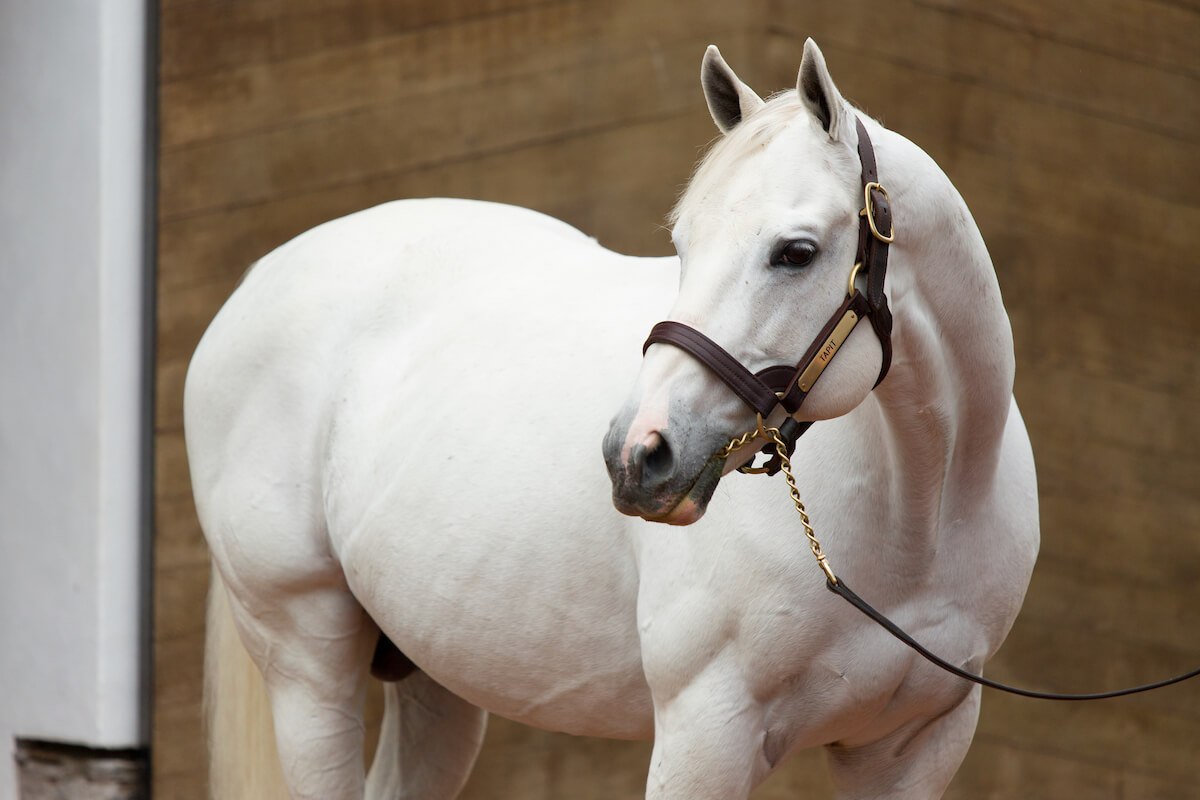
As the dominant Thoroughbred sire of his generation, record-breaking Gainesway stallion Tapit has achieved extraordinary success with his progeny both on the racetrack and in the sales ring. Not only was Tapit the champion sire of 2014 and 2015, but he also set North American progeny earnings records each season; he leads the sires’ list again in 2016 by more than $5 million. Tapit has sired 20 international Grade 1 winners and 20 seven-figure yearlings at public auction. He commands a $300,000 stud fee, the highest in North America.
Adding to Tapit’s mystique is one of his defining physical characteristics: his striking gray coat color. Many of Tapit’s offspring are also gray, and through Oct. 4 Tapit has been represented by gray-colored graded stakes winners Anchor Down, Creator, Cupid, Dancing House, Frosted, Lani, Mohaymen, Pretty City Dancer, and Scuba in 2016 alone. But are gray Tapits more likely to become elite racehorses than non-gray Tapits?
To answer this question, let’s begin at the genetic level. Tapit’s genes are such that he passes on his gray coat color to his offspring about half the time. He has sired 51% gray foals, 26% chestnut, 17% bay, and 5.9% dark bay. Across the general Thoroughbred population, grays are much less common; in fact, only 7.3% of the yearlings cataloged in the 2016 Keeneland September sale were gray.
If we assume coat color has no impact on racing performance, the color distribution of Tapit’s best runners should be proportional to that of his foals. Given that Tapit has 85 lifetime stakes winners, we would expect 43 to be gray, and indeed there are exactly 43. Tapit has 18 bay stakes winners (four more than expected), 18 chestnut stakes winners (four fewer than expected), and six dark bay stakes winners (one more than expected). At first glance, it might seem that bay Tapits are outperforming chestnut Tapits, but there is no statistically significant difference between any color groups at the 95% confidence level.
We see similar results with Tapit’s graded stakes winners and Grade 1 winners. He has 31 gray graded stakes winners (three more than expected) and 11 gray Grade 1 winners (one more than expected). Though the gray Tapits have slightly outperformed expectation on a numerical basis, the small variances can be compared to coin flips going one way or the other.
In conclusion, while at least half of Tapit’s stakes winners, graded winners, and Grade 1 winners are gray, the numbers are proportional to Tapit’s percentage of gray foals. Furthermore, the numbers indicate no coat color has a statistical advantage or disadvantage in terms of racing performance.

Tapit’s graded stakes winners by color
Gray (31): Anchor Down, Bandbox, Careless Jewel, Cassatt, Concord Point, Creator, Cupid, Dance Card, Dancing House, Dancinginherdreams, Dreamologist, Flashback, Frosted, Hansen, Headache, Hightap, Honorable Dillon, Joyful Victory, Just Wicked, Lani, Laragh, Mohaymen, Pretty City Dancer, Race Day, Scuba, Snowbell, Stardom Bound, Tapitsfly, West Coast Belle, White Rose, Zazu.
Bay (8): Constitution, Sweet Loretta, Tapizar, Time and Motion, Tonalist, Touching Beauty, Untapable, Walk Close.
Chestnut (12): Chachkova, Coup de Grace, Delightful Joy, Mufajaah, Panivino, Ring Weekend, Tapicat, Tapiture, Tell a Kelly, Tin Type Gal, Trappe Shot, War Echo.
Dark bay (4): Divining Rod, Prospect Park, Teen Pauline, Testa Matta.